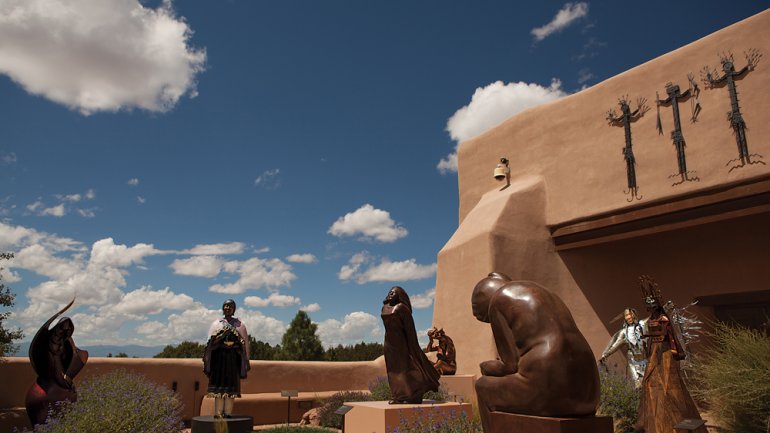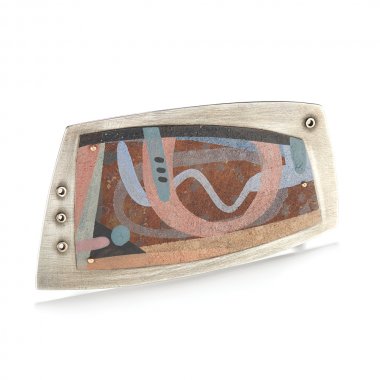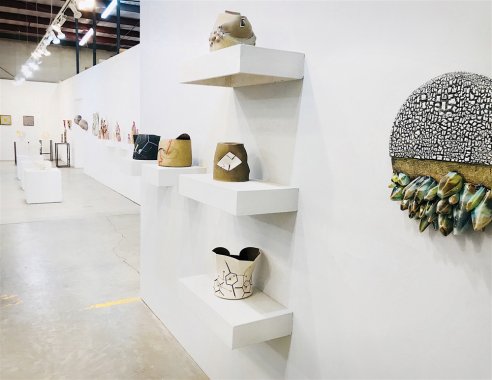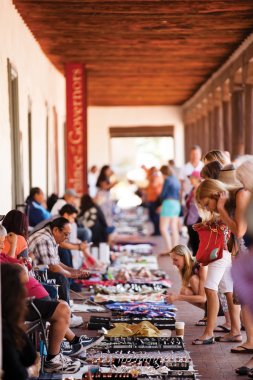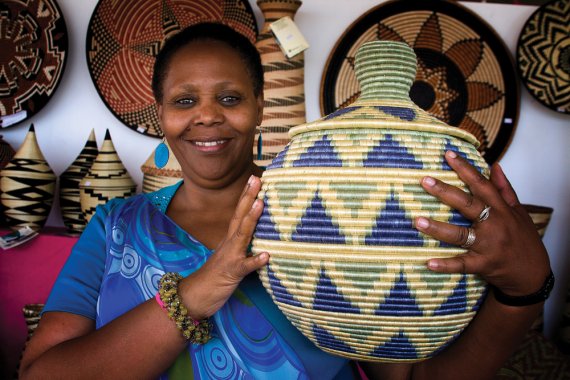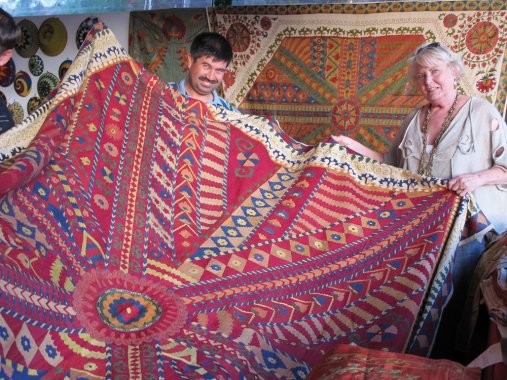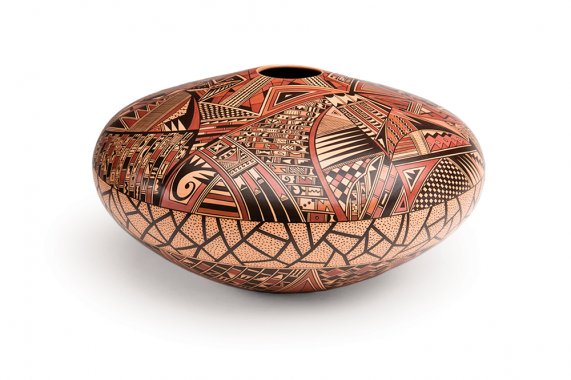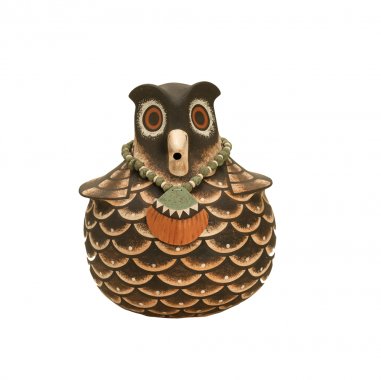Cultural Crossroads
Cultural Crossroads
Set in the sun-drenched Southwest landscape, Santa Fe is awash in dusty desert hues by day; by night, it glimmers with silver jewelry from shop windows. Stained-glass windows glow in its basilicas and chapels, while the 17th-century Palace of the Governors, one of the oldest public buildings in the US, stands as a testament to its colonial history. Witness the city’s low-slung adobe architecture, makers selling handmade wares on the sidewalks, and plethora of museums, galleries, and boutiques specializing in craft, and you won’t be surprised to learn that Santa Fe is part of the UNESCO Creative Cities global network, recognized for craft, folk art, and design.
Just a few blocks from the palace, now the home of the New Mexico History Museum, is the IAIA Museum of Contemporary Native Arts, part of the Institute of American Indian Arts college, about a 20-minute drive south. The institution has a mission to support and exhibit Native Americans working in the arts today, with a special focus on those in the Santa Fe area. “The way I think of it, as an indigenous person,” says artist and curator Sonya Kelliher-Combs, a past IAIA board member, “is we’re building on traditions every day. Tradition is not just something that lives in a box. It’s dynamic and living. Even though I work with new media, I’m influenced by these historical ways of learning and thinking and value systems.”
Ralph Scala echoes the sentiment. He’s a ceramist and instructor at Santa Fe Clay studio and gallery. For a long time, clay wasn’t hip, he says, but now he sees artists from other mediums getting “obsessed” with it. “What’s so cool is they’re not carrying those centuries of ceramic history on their back. When they’re looking at stuff fresh, they find a new way of working that makes you realize, ‘Oh yeah, you can do that.’ ” Recently, the organization, housed in a renovated warehouse just west of the IAIA, has begun offering an all-access pass for artists of all levels, which grants them unlimited studio access and participation in any of that season’s workshops. “There can be a ton of diversity within a class sometimes, which is great,” Scala says. “Somebody really familiar with the material next to someone new [to it] sparks ideas for the person beside them, and vice versa.”
Scala recently moved back to Santa Fe from Colorado, lured by the desert light. “It’s nothing short of magical,” Scala says. “Throughout the day, it changes.” His favorite time is when the last rays disappear. “You’re working on the edge of the light – it just gets sucked out of the studio, and your work is changed dramatically.”
A stroll across the train tracks from Santa Fe Clay brings you to the heart of the Railyard Arts District, with a grassy park and galleries filled with treasures. While the namesake Railyard Artisan Market gets much of the glory, El Museo Cultural de Santa Fe Winter Market across the street boasts a larger and more diverse inventory, often with more wallet-friendly prices. A variety of work, new and old – folk art, photography, books, leather, knives, and antique copper jewelry – draws collectors to the area, says Lesley Anne Martin, who helps manage the space. “The art world is so big and spread all over, but this is an art destination. You get the best of the best.”
Making the rounds in the Winter Market could take an entire afternoon, with handmade rugs from all over the world, racks of vintage clothing and boots, and baskets and beads galore. A businessman from Nepal stands just outside the door selling original and reproduction Navajo rugs at prices that could compete with trendy knockoffs sold online. A few booths down, Kewa Pueblo husband-and-wife duo Jeremy (Raincloud) and Eileen Rosetta show their modern jewelry in silver, brass, copper, and turquoise, work that often incorporates symbols and stories of the Pueblo people.
In Santa Fe, the past folds into the present, attracting makers who add their own spin to centuries-old traditions. This ethos of exploration, building on the rich history of the area and its people, permeates both the city and its maker culture, as whole new traditions are born.
IF YOU GO
Santa Fe Plaza
This central part of the city has kept its charm over the centuries. In front of the Palace of the Governors, artisans sit shoulder to shoulder selling jewelry and other wares. Browse their handmade gifts, then take a short walk to the circuit of museums that highlights Santa Fe’s maker history, including the IAIA Museum of Contemporary Native Arts and the New Mexico Museum of Art, the state’s oldest art museum and a prime example of Pueblo Revival architecture. Stop at Shiprock Santa Fe, a shop specializing in historic and contemporary Navajo work, including rugs and blankets, as well as designer furniture and fine art.
Take a breather at Santa Fe Plaza, the heart of the city and a historic landmark, before walking to Patina Gallery, which sells studio jewelry by luminaries such as local beadworker Claire Kahn as well as fine craft in other mediums. Round out your day at Keshi: the Zuni Connection, which showcases work by Zuni artists and specializes in wooden animal fetishes.
Railyard Arts District
Plan to spend a full morning at the Santa Fe Artists Market, held every Saturday from March through December in the burgeoning Railyard Arts District. (Be sure to stop at an ATM on the way, as many of the booths only accept cash.) Trendy shoppers will enjoy strolling through the smaller Railyard Artisan Market, held every Sunday from 10 a.m. to 4 p.m., where you’ll find contemporary takes on traditional jewelry. Cross the railyard to El Museo Cultural de Santa Fe Winter Market, where vendors from all over the world sell both contemporary and antique art from October through May.
From there, take a short walk to Form & Concept, a gallery dedicated to contemporary art, craft, and design. The gallery shows a wide variety of pieces ranging from New Mexico artist Jaque Fragua’s poignant neon wall pieces to local jeweler Bunny Tobias’ sculptural necklaces and art objects. While you’re in the area, be sure to stop by Santa Fe Clay to browse in their shop and gallery as well as peek into the studios of local potters.
Museum Hill
Museum Hill sits high above the city and provides a great view of the Santa Fe Botanical Garden below. Institutions to explore include the Museum of International Folk Art, the Museum of Indian Arts and Culture, and the Museum of Spanish Colonial Art.
Canyon Road
This half-mile arts district is a seven-minute drive from Santa Fe Plaza. The area is chock-full of boutiques, restaurants, and about 50 galleries, including Tansey Contemporary, which opens a show of Clare Belfrage’s handsome glass vessels on October 19.
